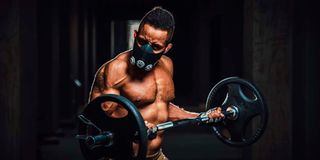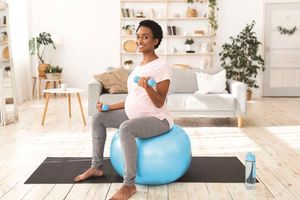Beginner shoulder exercises every man can do at home

Be careful about how much weight you can manage.
What you need to know:
- You will need dumbbells and enough space where your arms can raise to the ‘T’ position without obstruction.
- Hold a pair of dumbbells with your elbows pulled into your ribs and your arms palms facing each other. Hold this position as long as you can to build a base of strength.
- Taking on too much weight can lead to shoulder injuries
There are various ways to do exercises targeting your shoulders at home. These exercises will involve dumbbells which you can purchase online at between Sh. 1,200 for 2kg dumbbells and Sh. 4,200 for 12kg dumbbell set. Here are three types of beginner exercises you can do at home to build up your shoulders:
Lateral raises — 3 sets of 8–10 reps
According to Laura Williams, a certified fitness and exercise physiologist, nutrition specialist and author of Partner Workouts, you will need dumbbells and enough space where your arms can raise to the ‘T’ position without obstruction. Once you’re in this space, stand straight with your dumbbells in each hand, and your arms at your sides. In this position, your palms should be facing inside. Position your feet at roughly hip-distance apart. “Raise your arms at the same time, slightly then pause to ensure you disengage your trapezius muscle from the movement, and you target the deltoids as intended,” she says. “Lift the dumbbells up and out to each side, keeping your arms almost completely straight, stopping when your elbows reach shoulder-height and your body is forming a "T" shape. Breathe in as you lift.” Once at the top, pause and hold for a second for every movement. Then lower the dumbbells slowly. “Breathe out as you lower your dumbbells and take about twice as long to lower the weights as you took to lift them,” says Laura. As days go by, you can also do this exercise while seated. According to BodyBuilding (a physical fitness platform), when doing this exercise while seated, you will not have the ability to cheat the weight of the dumbbells by using your legs. At the same time, the weights will be able to go slightly underneath the bench you’ll be sitting on instead of going in front of you as they do when standing. This will give you improved motion.
Standing shoulder press — 3 sets of 6–8 reps
Hold a pair of dumbbells with your elbows pulled into your ribs and your arms palms facing each other. Hold this position as long as you can to build a base of strength. Then drive the dumbbells up to the top position with your hands over your shoulders and your biceps next to your ears. Focus on stabilising your body in this locked out position. Once you have mastered from the start to the end, you can safely add more weight to this exercise. Your muscle growth should correspond with the right weights.
Dumbbell upright rows — 2 sets of 8–10 reps
According BodyBuilding, be careful about how much weight you can manage with this exercise. For instance, taking on too much weight can lead to shoulder injuries. Also, you should not do this exercise if you suffer from shoulder injuries. According to BodyBuilding physical trainer Hildebrandt, start by holding each dumbbell in each hand, with your palms forward. The dumbbells should rest on top of your thighs. Your arms should be extended with a slight bend at the elbows, and your back should be straight. When in position, use your side shoulders to lift the dumbbells as you exhale. The dumbbells should be close to your body as you move it up. Your elbows should drive this motion. This means your elbows should always be higher than your forearms. Continue to lift them until they nearly touch your chin. When doing this exercise, you should keep your torso stationary and pause for a second at the top of the movement. Then lower the dumbbells back down slowly to the starting position. Inhale and repeat the routine.
Dumbbell front raise – 4 sets of 12 reps
This type of exercise will be effective in isolating the anterior deltoid muscles (the front of your shoulder). To do this exercise, stand upright and hold the dumbbells in front of you. Your palms should face your legs. “Keep your elbows and knees slightly bent as you raise your arms straight in front of you to shoulder level. Slowly return to the starting position,” says Laura. At the beginning, you will need to move up and down, two seconds up, two seconds down. When doing this, you should not lock out your elbows or lean back. As your body becomes accustomed, you may then increase your rests to 30 seconds. Once you perfect this exercise, you may start to combine it with your lateral exercises.




